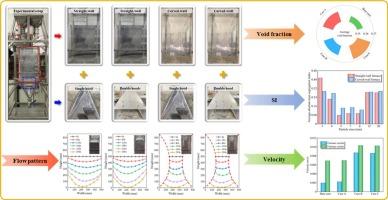采用实验和数值模拟方法研究了垂直冷却炉体结构对材料运动特性的影响
IF 7.5
1区 工程技术
Q2 ENERGY & FUELS
引用次数: 0
摘要
立式冷却炉在运行过程中,由于炉体结构的影响,经常出现物料偏析和流动停滞区。为了深入研究炉体结构对物料运动行为的影响,本文采用实验与数值模拟相结合的方法,分析了四种不同炉体结构下物料的流动形态、分布特征和空隙率分布。结果表明,炉壁形状对物料的流动形态和分布有更显著的影响。相比之下,导风罩的结构对材料空隙率的影响较大。在相同加料条件下,与直壁炉相比,弯壁炉有效减少了流动停滞区,物料流动更加均匀。双罩设计相对于单罩,可以大大增加底部材料的空隙率,从而提高底部材料的透气性。研究结果为立式冷却炉的结构优化提供了理论依据。本文章由计算机程序翻译,如有差异,请以英文原文为准。

Study on the effect of vertical cooling furnace body structure on material motion behavior using experimental and numerical simulation
During the operation of the vertical cooling furnace, material segregation and flow stagnation zone frequently occur due to the influence of the furnace structure. To study in depth the impact of furnace structure on the motion behavior of the material, this work combines experimental and numerical simulation methods to analyze the flow pattern, distribution characteristic, and void fraction distribution of the material in four different furnace structures. The findings show that the shape of the furnace wall has a more significant effect on the flow pattern and distribution of the material. In contrast, the structure of the air hood has a greater impact on the material void fraction. Under the same feeding condition, the curved-wall furnace effectively reduces the flow stagnation zone compared with the straight-wall furnace, and the material flow is more uniform. The double hood design can greatly increase the void fraction of the bottom material compared to the single hood, thereby improving the air permeability of the bottom material. The findings of this work provide a theoretical basis for the structural optimization of the vertical cooling furnace.
求助全文
通过发布文献求助,成功后即可免费获取论文全文。
去求助
来源期刊

Fuel
工程技术-工程:化工
CiteScore
12.80
自引率
20.30%
发文量
3506
审稿时长
64 days
期刊介绍:
The exploration of energy sources remains a critical matter of study. For the past nine decades, fuel has consistently held the forefront in primary research efforts within the field of energy science. This area of investigation encompasses a wide range of subjects, with a particular emphasis on emerging concerns like environmental factors and pollution.
 求助内容:
求助内容: 应助结果提醒方式:
应助结果提醒方式:


